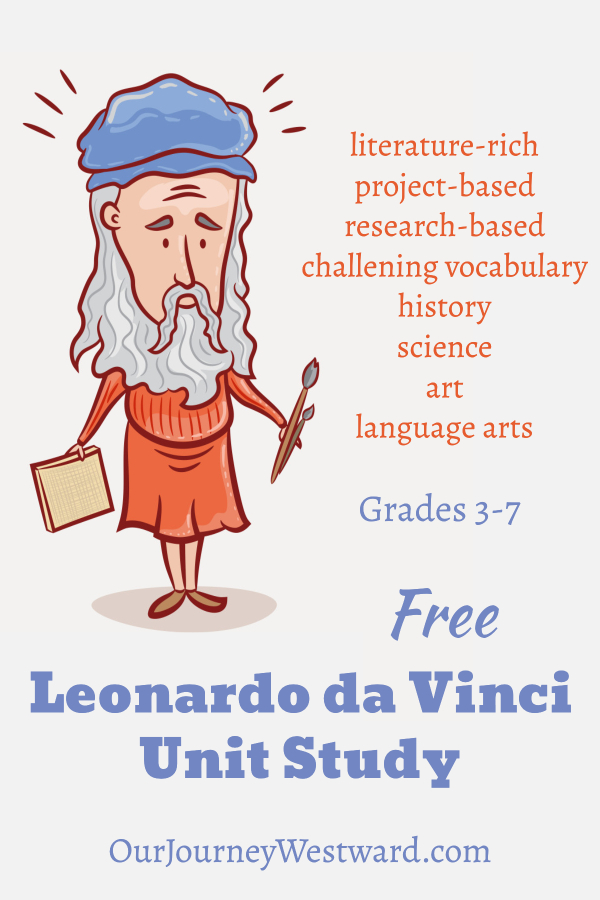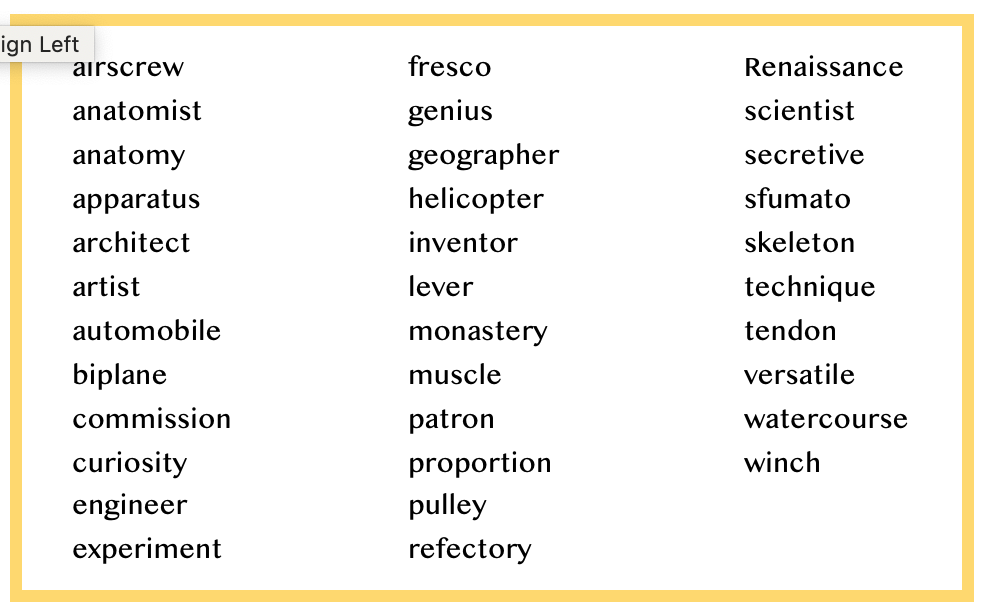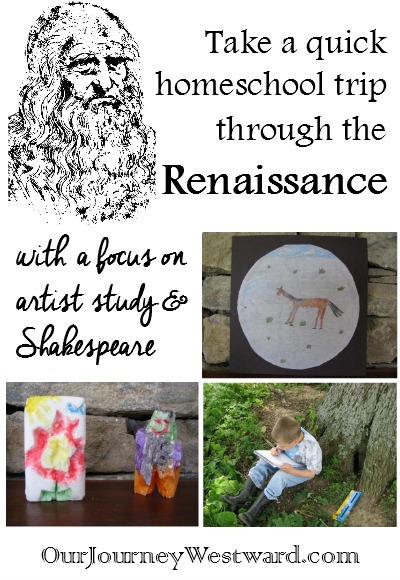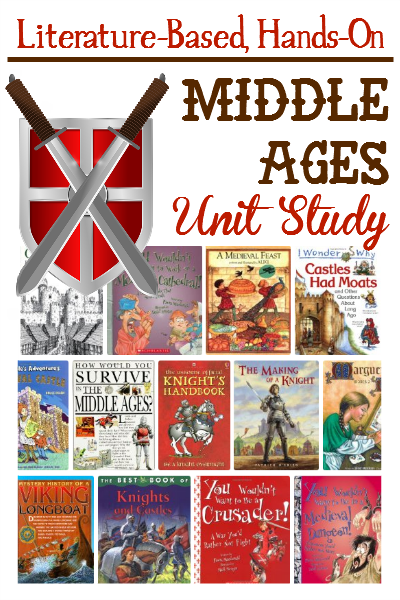A Quick Leonardo da Vinci Unit Study for Your Homeschool
I have always loved teaching a Leonardo da Vinci unit study. It quickly covers almost every academic subject, from the Renaissance to various science topics like inventions, simple machines, and the human body. History, science, and art combine with research-based learning and good books for a fabulous learning adventure!

Leonardo da Vinci Unit Study
Taking two or three weeks to study Leonardo da Vinci’s life and impact might inspire your kiddos to dream big and do hard things. His incredible inventions, discoveries, critical thinking, and art made quite an impact during his lifetime. They even reach far and wide into many modern-day technologies!
This simple unit study will give your students a nice overview of da Vinci’s life and work while allowing your children to dig deeper into various aspects they find most interesting.
This post contains affiliate links.
Leonardo da Vinci Books
A good unit study includes many varied books, and I have a great list of da Vinci titles. The library may have additional books to discover, too. Some are historical fiction, some are nonfiction, and some provide additional activity ideas. Some even go off the particular topic of da Vinci to cover more in-depth learning about science or history topics that fit well.
Books About da Vinci for Kids
Leonardo: Beautiful Dreamer by Robert Byrd
Leonardo and the Flying Boy by Laurence Anholt
Amazing Leonardo da Vinci Inventions You Can Build Yourself by Maxine Anderson
Leonardo da Vinci for Kids: His Life and Ideas, 21 Activities by Janis Herbert
Leonardo da Vinci: Dreams, Schemes, and Flying Machines by Heinz Kuhne
Monday with a Mad Genius by Mary Pope Osborne
Famous Artists: Leonardo da Vinci by Antony Mason
Leonardo da Vinci by Diane Stanley
Magic Tree House Research Guide- Leonardo da Vinci by Mary Pope Osborne
Books to Support a da Vinci Unit Study
Lives of the Great Artists by Charlie Ayres
Discovering Great Artists: Hands-On Art for Children in the Styles of the Great Masters by MaryAnn F. Kohl and Kim Solga
Eyewitness Books: Renaissance by Alison Cole
The Renaissance and the New World by Giovanni Caselli
Utterly Amazing Human Body by Robert Winston
Human Body! Knowledge Encyclopedia by DK
Human Body Factory: The Nuts and Bolts of Your Insides by Dan Green
The Kids’ Book of Simple Machines: Cool Projects and Activities That Make Science Fun by Kelly Doudna
Leonardo da Vinci Vocabulary
Here is a simple plan for introducing pertinent vocabulary from the unit study.
- Say a vocabulary word aloud. The student attempts to spell it. (The Logic of English Essentials curriculum is a great way to introduce spelling rules that stick.)
- Ask the student to use prior knowledge to guess what the word means. Use it in a sentence or remind him of a Latin or Greek root if he doesn’t know. If he still doesn’t know, expect him to look it up in a physical or digital dictionary, then encourage him to use the word in a sentence.

Project-Based Learning with Leonardo da Vinci
It’s appropriate to read several books during a quick unit study and then jump right into project-based learning.
Unit studies involving project-based learning promote higher-order thinking skills and infuse meaningful language arts. These research-based activities are excellent opportunities to encourage independent learning through research, writing, creating, and public speaking.
Rather than assigning particular projects, it can be helpful to provide a potential list of ideas for a student to choose from. For example, from the list below, it may be reasonable to expect students to choose 1-10 projects depending on their age and ability. Ensure that the selected projects cover a wide range of skills and topics.
With a bit of guidance when necessary, allow a student to pick and choose his tasks from our unit study activity lists. Choices help build independence and ownership, which ultimately make for better projects.
Leonardo da Vinci Learning Activity Ideas
Da Vinci is most widely known as the painter of the Mona Lisa and The Last Supper, but he was so much more. Keep a running list of da Vinci’s accomplishments as you progress through this unit study. (History, Science, Art, Language Arts, Social Studies)
Leonardo da Vinci famously kept a notebook of his many ideas and inventions. Begin keeping a notebook of ideas. (Life Skills, Language Arts, Critical Thinking)
Da Vinci was a nature lover and often sought the answers to his many questions, such as, “Why is the sky blue?” Research for yourself to find out why the sky IS blue. (Language Arts, Science)
Record a list of questions you’d like answered. Choose two to research to find what you’re looking for. (Language Arts, Science, History, Critical Thinking)
Leonardo was very secretive about his discoveries, so he composed all his notes in “mirror writing,” which means he wrote letters and words backward. Find out when Leonardo was born, where he was born, and when he died. Record your findings using mirror writing. (Language Arts, History)
Da Vinci was fascinated with the human body. Find a diagram of the human skeleton to print or trace. Learn the names of all of the major bones and label your diagram. (Language Arts, Science, Health, Art)
Leonardo calculated that the entire length of a body is eight times that of the head. This is called a proportion. According to his calculations, if someone’s head is eight inches long, how tall would they be? Measure yourself and others in your family to see if da Vinci’s proportion calculation holds true. (Math)
Da Vinci was very interested to learn about the flight of birds. Find a YouTube video or documentary to watch about the flight of birds. Create a sketch and write a paragraph to describe what you learn. (Language Arts, Science, Art)
Of all birds, da Vinci enjoyed watching vultures the best because of their ability to glide. Watch a video of a vulture gliding. Take a nature walk to observe the flight of various birds. Discuss with someone in your family the similarities and differences between the flight of vultures and other birds. (Language Arts, Science)
Da Vinci was a brilliant inventor. Use craft supplies and recyclables to create your own invention. Be ready to demonstrate and explain it to your family. (If you can get your hands on the book Amazing Leonardo da Vinci Inventions You Can Build Yourself, it’s a great resource if you aren’t sure where to begin with your invention.) (Critical Thinking, STEAM)
Leonardo da Vinci did a lot of experiments using simple machines. Research to learn the six simple machines. Draw a few common tools you use around the house and label which simple machines are included in that tool. For instance, scissors are made of wedges and levers. (Language Arts, Science, Art)
Visit this simple machine experiment page and choose one or two experiments to complete. (Science, Critical Thinking)
Da Vinci’s Mona Lisa is likely the most famous painting in the world. Find a photo or print of the Mona Lisa and study it. Do you recognize it? What do you think? What do you notice? How does it make you feel? Discuss with someone in your family, or write a paragraph to share your thoughts. (Art, Language Arts)
The Mona Lisa is in a museum in Paris, France, called the Louvre. Locate Paris on a map. Research to find four other tourist sites you might choose to visit if you ever have a chance to go to Paris. If you’d like to learn more about each site, including the Louvre, find YouTube video tours to watch. (Language Arts, Art, Geography)
Another famous da Vinci painting is a fresco called The Last Supper. Study a photo or print of it and list at least 10 things you notice. Learn how to create a fresco. If you have easy access to the materials, try making a fresco. (History, Art, Language Arts)
Leonardo was born during the Renaissance. Study this time period. Create a chart to compare and contrast it with modern times. (History, Language Arts)
Make a list of four other famous artists from the Renaissance period. Print off an image of each of their most famous works of art and create a chart. Use the chart to help you discuss the similarities and differences between their artworks with your family. (Art, History, Language Arts)
Leonardo da Vinci used to enjoy drawing both the outside and inside of objects. Find something to take apart. (Make sure it’s okay with your parents first!) Some ideas are a squirt gun, a flashlight, a ballpoint pen, or an old appliance. Draw it from the outside first, being as accurate as possible. Next, take it apart and draw its inside, including all the individual pieces. Label it if you can, just like Leonardo would have. (Art, Language Arts, Critical Thinking, Science)
Find someone to sit as your model and paint a portrait like the Mona Lisa. (Art)
On August 21, 1911, the Mona Lisa was stolen. Find out what happened and how it was recovered. Write a newspaper article about the incident. (Language Arts, History, Art)
Gather as much information as you can about the life of Leonardo da Vinci. Dress in costume as if you are da Vinci and tell the story of his life to your family. You may use visuals to aid in the storytelling. (Language Arts, History, Art, Drama)
Printable Leonardo da Vinci Unit Study
For your convenience, here is a quick reference to this post’s books, vocabulary, and activity ideas! Enter your email address below to grab the 6-page printable Leonardo da Vinci unit study.
Recommended Products
Extend or expand your study of Leonardo da Vinci with the Famous Artists of the Renaissance Guided Artist and Picture Study for 3rd-8th Grades. Teaching about other famous artists of the Renaissance is easy with this complete curriculum, which covers the art era, biographical information about three Renaissance artists, and various art styles of those artists. Picture study, notebooking pages, and art creation are encouraged.
Learn more about how to plan unit studies or learn how to incorporate project-based learning through these Homeschooling Masterclasses. How to Plan Effective Unit Studies and Homeschooling with Project-Based Learning clearly teach parents through video instruction. Concise but thorough, these masterclasses provide easy ideas for implementing these practices in your homeschool immediately.
-
Famous Artists of the Renaissance
$12.00 -
Unit Study Masterclass
Original price was: $20.00.$10.00Current price is: $10.00. -
Project-Based Learning in the Homeschool
Original price was: $20.00.$10.00Current price is: $10.00.
Recommended Blog Posts
These blog posts can help you plan more literature-rich, project-based learning unit studies about the Middle Ages and Renaissance eras!


























Hi Cindy,
I am a new homeschooling mom and I’m interested in getting a monthly science box for my son who just turned nine. I see there are a lots of options and was curious if you’ve ever tried/have an opinion on them. Thanks so much.
Hi, April! I have not tried any of the monthly science boxes thus far. Which ones are you considering? I can see if any of my blogging friends have an opinion on them.
Hi Cindy,
The ones I was was tossing around were~Spangler, Tinker, or BitsBox.
Compiled from a couple of my blogger friends who have experience with each of those kits…
They’re each totally different. Spangler is science experiments. Bitsbox is coding. Tinker is engineering. It depends on what the child’s interests are as they’re all very good kits.